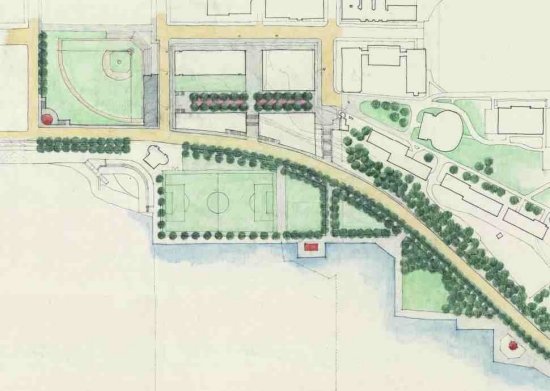Is City of Hoboken squandering an opportunity that could be its greatest legacy?
By Ron Hine | FBW | December 15, 2013
In 1995, the City of Hoboken adopted a redevelopment plan for Hoboken’s South Waterfront that embraced most of the principles espoused by the Fund for a Better Waterfront (FBW). All the land on the river-side of Sinatra Drive became a public park, beautifully landscaped including several hundred London planetrees. All of the east-west streets brought people directly to the waterfront and the waterfront park. The development on the three new blocks created hid the interior parking lots with ground floor retail and office or residential space above, thus providing for a lively streetscape.
This plan resulted following two waterfront referendums in 1990 and 1992 that defeated ill-conceived plans put forth by the City and Port Authority of New York & New Jersey. There was a vigorous public debate that ensued during those years. FBW created its own waterfront plan for Hoboken, wrote a book detailing how that plan could be implemented and built a 4 foot by 12 foot architectural model to help people understand the extraordinary potential presented at Hoboken’s post-industrial waterfront which at that point had not experienced any new development.
The 1995 redevelopment plan stopped at Fourth Street. This is where the bike path dead-ends as does the generous canopy of trees. North of Fourth, Sinatra Drive becomes an overly-wide, looping roadway that encourages speeding traffic. Opportunities to create more open space and connect missing links in Hoboken’s proposed continuous, public waterfront park have gone unrealized during the past three administrations.
In the past four years, FBW has worked to refine its plan for the central waterfront. It has engaged with City officials, Stevens Institute of Technology, Little League coaches, the Hoboken American Legion and other stakeholders. Yet, the public debate on this issue has been remarkably absent compared to 20 years ago. And the willingness of the current administration — which has been a strong advocate for open space and “complete” streets — to engage in detailed discussions about a plan has been sorely lacking.
In October, the City of Hoboken sent out a request for proposals for “Sinatra Drive Visioning and Conceptual Design Plan.” The point system the administration used for selecting the one proposal out of the eleven submitted reveals a flawed process. The team selected should be the one that best defines the vision and design concept for what Hoboken’s central waterfront could be. The Kimley-Horn proposal is severely limited in scope, focusing on fixing Sinatra Drive and ignoring a myriad of other issues that a sound plan needs to address.
The administration failed to bring this issue before the appropriate City Council committees. After the resolution was withdrawn at the December 4 City Council meeting, the administration is now attempting to push it through again at this Wednesday’s meeting. A December 13th letter from the mayor to the City Council claims that failure to pass the resolution approving the contract will lead to a six-month delay.

FBW’s 2001 plan for the Castle Point-Stevens Institute portion of Hoboken’s waterfront.
The following are some of the issues that the current proposal has failed to address: 1) the realignment of Sinatra Drive provides an opportunity to extend left field line at Little League ball park, thus making it regulation-size; 2) a new plan could result in building a better World War II memorial by reconfiguring and resituating the existing one; 3) creating T-intersections at the waterfront for Fourth and Fifth Streets would result in typical Hoboken streets, more public open space, a continuation of the bike path and more land for Stevens Institute to develop west of Sinatra Drive/north of Fifth; and 4) acquiring Union Dry Dock (it is currently for sale) for a public park would connect Castle Point Park to Maxwell Place Park, thus completing an important link in Hoboken’s waterfront park.
Another consideration in hiring a firm would be its ability to line up the federal transportation funds to get this portion of the waterfront built, including a realignment of Sinatra Drive, making this road pedestrian and bicycle-friendly. This will be a multi-million dollar project. The federal transportation dollars are the single best source for completing such an important project. There is no mention of this in the proposal selected by the City. This plan also needs to include creative approaches that would make it possible to acquire Union Dry Dock.
A plan for the waterfront from Fourth Street up to Eleventh is a rare chance to make Hoboken’s waterfront world-class. This is a once-in-a-century, grand opportunity. If done right, this could be the most important legacy for the Mayor, the City Council and our community as a whole.
Related links
NJ-APA 2013 Great Places in NJ
Plan for the Hoboken Waterfont
Fund for a Better Waterfront History
Roots Over the River
Col. Stevens’ plan for Hoboken
FBW Waterfront Plan Featured

